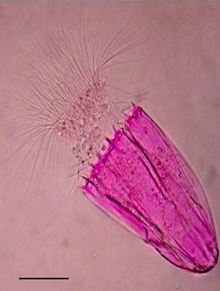Loricifera - Simple English Wikipedia, the free encyclopedia
| Loricifera | |
|---|---|
 | |
| Pliciloricus enigmatus | |
| Scientific classification | |
| Kingdom: | |
| (unranked): | |
| Phylum: | Loricifera Kristensen, 1983 |
| Order: | Nanaloricida |
Loricifera [1] is a recently discovered ecdysozoan phylum of marine animals. The phylum includes the first animals known to exist in a completely anoxic environment (no oxygen at all).[2] The phylum was described in 1983 by Reinhardt Kristensen.[3]
They are a phylum of very small animals which live in sediment. There are now twenty-two described species, in eight genera.[4][5] In addition, there are about 100 more species which have been collected, but not yet described.[4] Their size ranges from 100 µm to about 1 mm.[6]
Their habitat is in the spaces between marine gravel to which they attach themselves. They are among the most recently discovered groups of Metazoans.[7] They attach themselves quite firmly to the gravel, and this explains why they remained undiscovered for so long.[5] The first specimen was collected in the 1970s, and later described in 1983.[7] They are found at all depths of water, in different sediment types, and in all latitudes.[5] They have not yet been found in the fossil record.
Anatomy
[change | change source]These animals have a protective outer case called a lorica. Protected by the lorica, the animals have a head, mouth and digestive system. Development is usually direct, though there are larvae in some species. The animals have two sexes as adults. There are some complex and flexible life cycles with different forms of parthenogenetic reproduction.[4]
Their closest relatives are thought to be the Kinorhyncha and Priapulida, with whom they share some characteristics. Together they make up the clade Scalidophora.[3][7]
In anoxic environments
[change | change source]
Three species of Loricifera have been found in the sediments at the bottom of the L'Atalante basin in the Mediterranean Sea. The 'surface' of this basin is 3,500 meters down. They are the first multicellular organisms known to spend their entire lives in an oxygen-free environment. It is thought they are able to do this because they rely on organelles which, unlike normal mitochondria, do not use oxygen for their energy cycle.[2][8][9][10] They are able to do this because they use hydrogenosomes to get their energy rather than mitochondria.
The newly reported animals complete their life cycle in the total absence of light and oxygen, and they are less than a millimetre in size.[11] They were collected from the deep basin where they live in a nearly salt-saturated brine. This brine, because of its density, does not mix with the waters above.[11] As a result, the brine is completely anoxic, and high in ammonia. Also, due to the action of sulphate reducers, it contains sulphide at a high concentration.[11] In the brine, the abundance of cells is not high. Extremophiles predominate, including members of the deep-sea hydrothermal vent community of archaea and bacteria.[12] Eukaryotes are also found in l'Atalante, including ciliates (45%), dinoflagellates (21%) and choanoflagellata (10%).[13]p360–381
References
[change | change source]This article incorporates CC-BY-2.0 text from references [11][14]
- ↑ from Latin, lorica, corset + ferre, to bear
- ↑ 2.0 2.1 Fang, Janet (2010). "Animals thrive without oxygen at sea bottom". Nature. 464 (7290): 825. doi:10.1038/464825b. PMID 20376121. S2CID 4340458. Retrieved 2010-04-06.
- ↑ 3.0 3.1 Heiner I. & Kristensen R.H. 2005. Two new species of the genus Pliciloricus (Loricifera, Pliciloricidae) from the Faroe Bank, North Atlantic. Zoologischer Anzeiger. 243: 121–138.
- ↑ 4.0 4.1 4.2 Gad G. 2005. Successive reduction of the last instar larva of Loricifera, as evidenced by two new species of Pliciloricus from the Great Meteor Seamount (Atlantic Ocean). Zoologischer Anzeiger. 243: 239–271.
- ↑ 5.0 5.1 5.2 Ruppert, Edward E., Richard S. Fox, and Robert D. Barnes. 2004. Invertebrate zoology. 7th ed. Toronto: Brooks/Cole—Thomson. p776.
- ↑ Heiner I. 2005. Preliminary account of the loriciferan fauna of the Faroe Bank (NE Atlantic). Biofar Proceedings 2005: 213–219.
- ↑ 7.0 7.1 7.2 Kristensen, R.M. 2002. An introduction to Loricifera, Cycliophora, and Micrognathozoa. Integrative and Comparative Biology. 42: 641–651.
- ↑ Milius, Susan (2010). "Multicelled animals may live oxygen-free". Science News. Society for Science and the Public. Archived from the original on 23 May 2010. Retrieved 11 April 2010.
- ↑ Oren A. (ed) 1998. Microbiology and biogeochemistry of hypersaline environments. (Microbiology of extreme & unusual environments). CRC Press. ISBN 0-8493-8363-3
- ↑ Vreeland R.H. & Hochstein L.I. 1992. Biology of halophilic bacteria. CRC Press. ISBN 0-8493-8841-4
- ↑ 11.0 11.1 11.2 11.3 Mentel M. & Martin W. 2010. Anaerobic animals from an ancient, anoxic ecological niche. BMC Biology 8, 32. doi:10.1186/1741-7007-8-32. [good summary]
- ↑ Yakimov, Michail M. et al. 2007. Primary producing prokaryotic communities of brine, interface and seawater above the halocline of deep anoxic lake L'Atalante, Eastern Mediterranean Sea. The ISME Journal, Nature Publishing Group. 1, 743–755. doi=10.1038/ismej.2007.83
- ↑ Alexander, Eva et al. 2009. Microbial eukaryotes in the hypersaline anoxic L'Atalante deep-sea basin. Society for Applied Microbiology. 11 doi=10.1111/j.1462-2920.2008.01777.x Archived 2013-01-05 at Archive.today
- ↑ Danovaro R. Dell'Anno A. Pusceddu A. Gambi C. Heiner I. & Kristensen R.M. 2010. The first metazoa living in permanently anoxic conditions. BMC Biology 8: 30. doi:10.1186/1741-7007-8-30


 French
French Deutsch
Deutsch